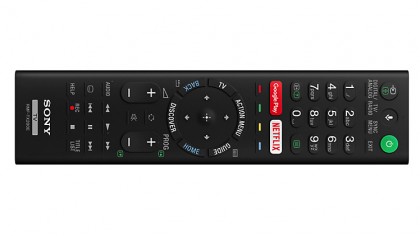Why you can trust TechRadar
Unfortunately the 65X930D isn't one of the easiest TVs to maneuver around. The main reason for this is the new remote control Sony has introduced for its high-end 2016 TVs. It doesn't offer any of the pared-back button counts or touch pad control options most other brands offer with their smart TVs.
Far worse, though, is Sony's bizarre decision to make the buttons sit almost flush with the remote control's housing. This might look cool, but it proves a disastrous move in usability terms, making it all but impossible for you to know where on the remote your thumb is without looking down at it - a particularly problematic situation if you're watching TV in a darkened room.
As noted earlier I'm also not Android TV's biggest fan. I find the interface overwhelming, cluttered with junk that suggests little understanding of what most people (though obviously not all) really want from a smart TV service, and far too short of customisation options.

Sony's picture calibration tools aren't particularly standard in their presentation and labelling either, though they do ultimately offer everything you will likely need.
Subpar sound
Sony's pronounced emphasis on slimness with the 65X930D's design means that you won't find any trace of the incredibly powerful, large magnetic fluid speakers that have been such a feature of Sony's high-end TVs for the past couple of years.
While this is probably a welcome move from an aesthetic point of view, the impact on sound quality is pretty devastating. Sony's magnetic fluid speaker TVs were the best sounding 'mainstream' sets we'd ever heard, and the 65X930D sounds disappointingly average.

A general lack of bass in the mix can leave loud moments sounding brittle and thin, while a lack of power and directness means the soundstage will come off sounding slightly vague and wispy rather than full of attack and directness.
Sign up for breaking news, reviews, opinion, top tech deals, and more.
Voices, at least, sound generally convincing, and the mid-range space available to the TV is large enough to enable the TV to sound reasonably immersive with relatively untaxing soundtrack moments. The bottom line, though, is that there are plenty of premium TVs out there that sound better than the 65X930D.
Value
The 65X930D's $3,299 asking price is not excessive by any means for a TV that introduces an innovative new picture technology in the service of delivering what's currently the last word in picture quality: 4K HDR. Especially when that technology is housed in bodywork as aggressively stylish as the one wrapped around the 65X930D. There's ultimately no avoiding, though, the fact that your $3,299 isn't getting you picture perfection.
Admittedly Sony's 65X930D flies out of the traps with all guns blazing. Its ultra-slim design is a sight to behold, especially in the context of its huge 65-inch screen. It also uses an all-new backlight system designed to optimise its HDR playback, and that headline HDR support is backed up by excellently realised native 4K resolution. Its smart features combine Android TV and YouView too, and for much of the time its picture quality is sensational. It's just a shame the new backlight system ultimately turns out to be in need of more refinement.
We liked
The 65X930D's svelte form set my pulse racing, and its YouView integration is a great smart TV touch. There are times, too, when its 4K HD picture quality sets new standards, and it looks lovely with standard dynamic range pictures too.
We disliked
The backlight can cause distracting light 'blocks' around bright objects during HDR viewing, and the TV's audio is rather average. The remote control is pretty nightmarish to use too, and Android TV lacks refinement (though not content) as a smart TV system.
Verdict
There were plenty of times during my time with the 65X930D where I found myself staring in awe at its HDR 4K pictures. The combination of contrast, color and detail adds up to pictures of almost magical cinematic beauty. To some extent, though, this just makes the wrench you feel when the beauty is disrupted by obvious backlight blocking problems all the more distracting.
There's no doubt that Sony's new backlight system has potential once Sony irons out its current wrinkles. For now, though, its issues with dark HDR scenes are, sadly, just troubling enough to prevent me from being able to give this often stunning TV an unqualified recommendation.

John has been writing about home entertainment technology for more than two decades - an especially impressive feat considering he still claims to only be 35 years old (yeah, right). In that time he’s reviewed hundreds if not thousands of TVs, projectors and speakers, and spent frankly far too long sitting by himself in a dark room.
